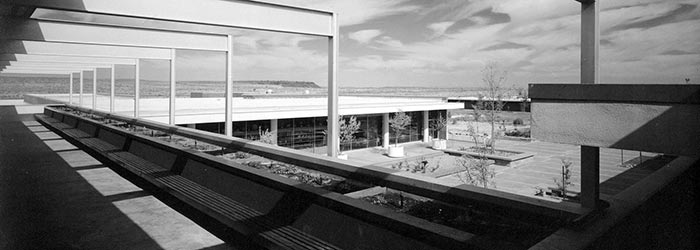
Petrified Forest was first established as a National Monument by President Theodore Roosevelt in 1906. In the Monument’s earliest days, its development needs were supplied by the community of Adamana, where visitors would arrive by train, take horse-drawn coaches to see the petrified wood, and where the park’s earliest employees lived.
In the 1920s, when more visitors were arriving by automobile, the Rainbow Forest Lodge building was built with housing behind it, as well as a house for the park’s superintendent on Agate Mesa.
The Rainbow Forest Lodge building, where the gift shop is today, is the same building, although it has been modified a great deal over the years and has lost its historic character. A few wood-framed buildings in the Rainbow Forest area and one at Crystal Forest were also built around this time.
As with many parks and monuments across the country, it was the Depression of the 1930s and the creation of the Civilian Conservation Corp that resulted in the first building boom at Petrified Forest.
The Rainbow Forest Museum was built right on the edge of the petrified wood deposit, with the Giant Logs Trail starting at the back door. Employee houses with garages, a maintenance shop, and a vehicle fueling building were also built.
A water system was installed with a well near the Puerco River, a pipeline of about 12 miles to a water storage tank, and a distribution system to all the buildings at Rainbow Forest.
All these buildings were constructed of sandstone quarried from the area. The buildings and a portion of the waterline are still in service.
The Painted Desert Inn, at the north end of the current park, was built initially by Herbert Lore in the 1924 on his private property from petrified wood gathered from the area before it became part of the monument.
His intent was to provide services to Route 66 travelers. When the monument was authorized to expand north in the 1930’s to provide park access from Route 66, one of the first properties acquired was Mr. Lore’s Inn, in 1936.
The CCC then converted the structure into the Santa Fe style pueblo that it is today, under the direction of Mary Jane Colter, architect of the Fred Harvey Company, who would manage the property.
The Painted Desert Inn was closed for a period between 1963 and 1975, and then opened only seasonally until 1992. It was substantially rehabilitated in 2005 and is designated a National Historic Landmark.
By the 1950s, many more visitors were coming to national parks and monuments and the 1930s infrastructure was no longer up to the task in many places.
The National Park Service requested and was granted a ten-year building budget to improve facilities in time for the agency’s 50th anniversary in 1966.
The program became known as Mission 66. Petrified Forest was promised in 1958 that, if all the authorized lands were acquired, the National Monument would become a National Park, which it was in 1962.
Route 66 was also being replaced in the area of the park by Interstate 40, which opened in 1963. With a newly expanded and designated park and a new interstate highway, the National Park Service decided Petrified Forest was the right site for a bold new facility that would introduce travelers to the National Park system and be designed in the modern architectural style of the time.
The Painted Desert Community Complex, designed by famed modern architects Richard Neutra and Robert Alexander, was among the most ambitious projects undertaken across the country for its scale and the architectural statement it made.
Its scale included all functions needed to run a national park—commercial visitor services, a visitor center (a concept developed for Mission 66), administrative offices, maintenance shops, a variety of employee housing, and community facilities for employees and their families.
By hiring Neutra and Alexander, the NPS fully embraced modern architecture and redefined the relationship between buildings in parks and their environment—instead of local materials assembled by hand as most rustic structures were, the modern style looked machine made with flat surfaces and crisp lines but included lots of glass and ways to connect interior to exterior spaces.
Although structural challenges have plagued the Complex from the start and the park decided to tear it down in 1993, that decision was reversed in 2004 and the Complex still serves most of its intended functions today.
Very little has been built at Petrified Forest since the 1960s, and nearly everything built through the 1960s is on the National Register of Historic Places.
Recent rehabilitation projects include removing the suspended ceiling from the original room of the Rainbow Forest Museum to re-expose the concrete ceiling and two original skylights. That project also restored the original scored and painted concrete floor in that room.
Several projects were undertaken at the Painted Desert Community Complex, mostly structural stabilization, window upgrades, and energy improvements, including a solar array that supplies the Community Building and School with all the power needed.
The park entered into a partnership with the National Trust for Historic Preservation from 2014 to 2016 for the sustainable rehabilitation of the Complex, particularly focused on restoring the character-defining features such as the glass storefront on the Painted Desert Oasis building (concession building).
That project was accomplished in 2017 through a grant from the American Express Foundation, through the National Trust, matched by the National Park Service Centennial program.
The Painted Desert Community Complex was designated as a National Historic Landmark in 2016.